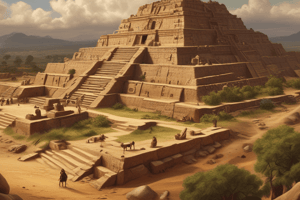Podcast
Questions and Answers
¿Cuál fue una de las formas de arte más famosas de la cultura Mochica?
¿Cuál fue una de las formas de arte más famosas de la cultura Mochica?
- El Templo de las Siete Ventanas
- El Mural de la Montaña
- La Tumba de los Pájaros (correct)
- La Estatua del Dios Mochica
¿En qué destacó la arquitectura de la cultura Mochica?
¿En qué destacó la arquitectura de la cultura Mochica?
- Por sus grandes estatuas de líderes Mochica
- Por sus torres defensivas en la costa
- Por sus estructuras con ventanas que permitían el ingreso de luz solar (correct)
- Por sus laberintos subterráneos
¿Qué cultivos cultivaban los Mochica con sus sofisticados sistemas agrícolas e irrigación?
¿Qué cultivos cultivaban los Mochica con sus sofisticados sistemas agrícolas e irrigación?
- Arroz, caña de azúcar y patatas
- Plátano, café y tabaco
- Papas, trigo y cacao
- Maíz, frijoles y algodón (correct)
¿Cuál fue uno de los logros significativos de la civilización Mochica?
¿Cuál fue uno de los logros significativos de la civilización Mochica?
¿Dónde se encontraba la Tumba de los Pájaros, una importante obra artística de la cultura Mochica?
¿Dónde se encontraba la Tumba de los Pájaros, una importante obra artística de la cultura Mochica?
¿Cuál fue uno de los logros tecnológicos más destacados de la civilización Mochica?
¿Cuál fue uno de los logros tecnológicos más destacados de la civilización Mochica?
¿Cómo reflejaban los Mochica su expresión religiosa en su arte y arquitectura?
¿Cómo reflejaban los Mochica su expresión religiosa en su arte y arquitectura?
¿Qué papel desempeñaban los 'mitmaqkuna' en la estructura social de la civilización Mochica?
¿Qué papel desempeñaban los 'mitmaqkuna' en la estructura social de la civilización Mochica?
¿Cuál era el propósito principal de las 'Tinjaras' desarrolladas por los Mochica?
¿Cuál era el propósito principal de las 'Tinjaras' desarrolladas por los Mochica?
¿En qué aspecto se destacaba la habilidad textil avanzada de los Mochica?
¿En qué aspecto se destacaba la habilidad textil avanzada de los Mochica?
Flashcards are hidden until you start studying
Study Notes
La Cultura Mochica: Exploring Art, Architecture, Agriculture, Religion, and Social Structure
The Mochica civilization thrived along the coast of present-day northern Peru between 100 BCE and 700 CE. This ancient culture made significant strides in art, architecture, agriculture, and religious practices, which have left a lasting impact on our understanding of pre-Columbian civilizations.
Art and Architecture
The Mochica culture was celebrated for its artistic and architectural achievements. One of their most famous art forms was the "Tumba de los Pájaros" (Bird's Tomb), discovered in the 1920s near the city of Sipán. This large, intricately decorated tomb is a testament to the Mochica civilization's prowess in creating awe-inspiring art.
Their architecture was also noteworthy, with structures such as the Temple of the Seven Windows in the city of Moche. This temple's architecture was unique for its time, featuring seven windows that allowed sunlight to enter, enhancing the sacred space.
Agriculture and Irrigation
The Mochica civilization's success was built upon their sophisticated agricultural and irrigation systems. They developed new techniques to cultivate crops such as corn, beans, and cotton. The establishment of a complex irrigation system, including canals and reservoirs, allowed the Mochica to thrive in the arid coastal landscape.
Their agricultural practices were not only efficient but also innovative. The Mochica used raised fields (known as camellones) to create fertile land above wetlands and swamps. This technique allowed them to cultivate crops and protect themselves from potential floods.
Technological Achievements
The Mochica civilization was skilled in creating various tools and technologies that reflect their ingenuity. Among their most notable achievements were their ceramics, which were not only decorative but also functional. For example, their Tinjaras were large, earthenware jars used for storage and transportation.
The Mochica also developed intricate systems for weaving and textile production. The Mochica were known for their vibrant, colorful garments and the use of cotton and alpaca fibers. Their weaving techniques were so advanced that they could create intricate geometric patterns, known as ikats.
Religion and Mythology
The Mochica civilization was deeply religious, with a complex mythology that centered around their deities Aiapáca and Mama Aire. Their religious expressions were reflected in their art, architecture, and even their clothing.
The Mochica also practiced ritualistic human sacrifice, believing that it was a way to appease their gods. This practice is evident in the discovery of the Tumba de los Pájaros, wherearchaeologists found evidence of ritualistic human sacrifices.
Social Structure
The Mochica civilization's social structure was complex and hierarchical. The top of the social pyramid was made up of a few elites who controlled the city-states. The elites were responsible for managing agriculture, trade, and religious practices.
The commoners, or mitmaqkuna, were responsible for cultivating the land, performing tasks for the elites, and serving in the army. The mitmaqkuna were also expected to perform religious ceremonies to appease the gods.
The Mochica civilization was a thriving and diverse culture that has left a lasting impact on our understanding of pre-Columbian civilizations. Their achievements in the areas of art, architecture, agriculture, religion, and social structure demonstrate the ingenuity of this ancient culture and the importance of preserving our heritage.
Studying That Suits You
Use AI to generate personalized quizzes and flashcards to suit your learning preferences.




